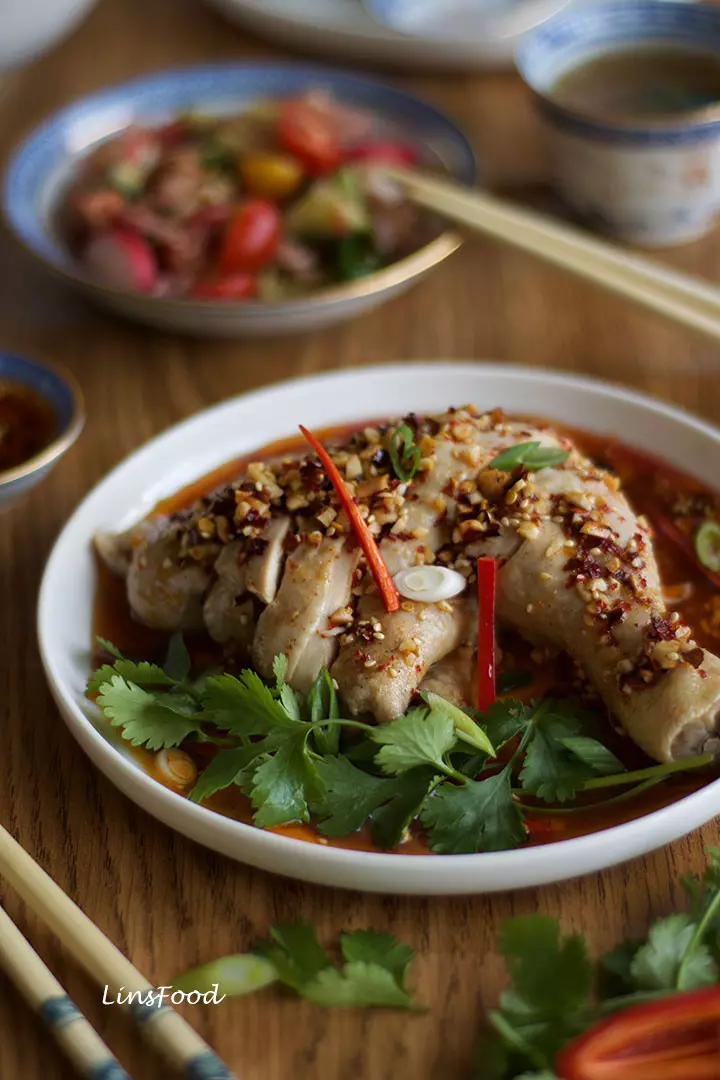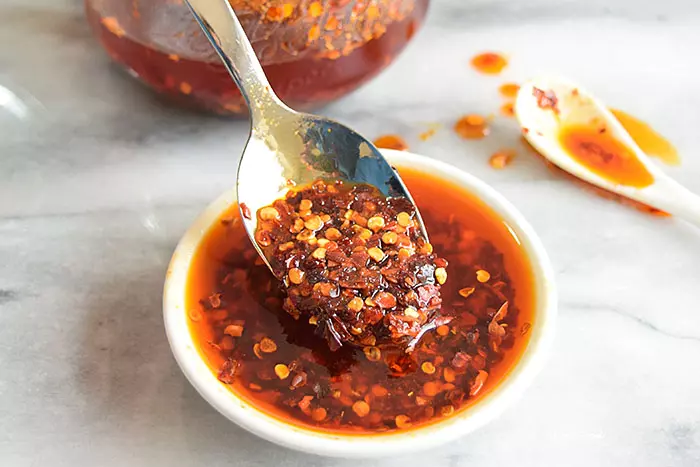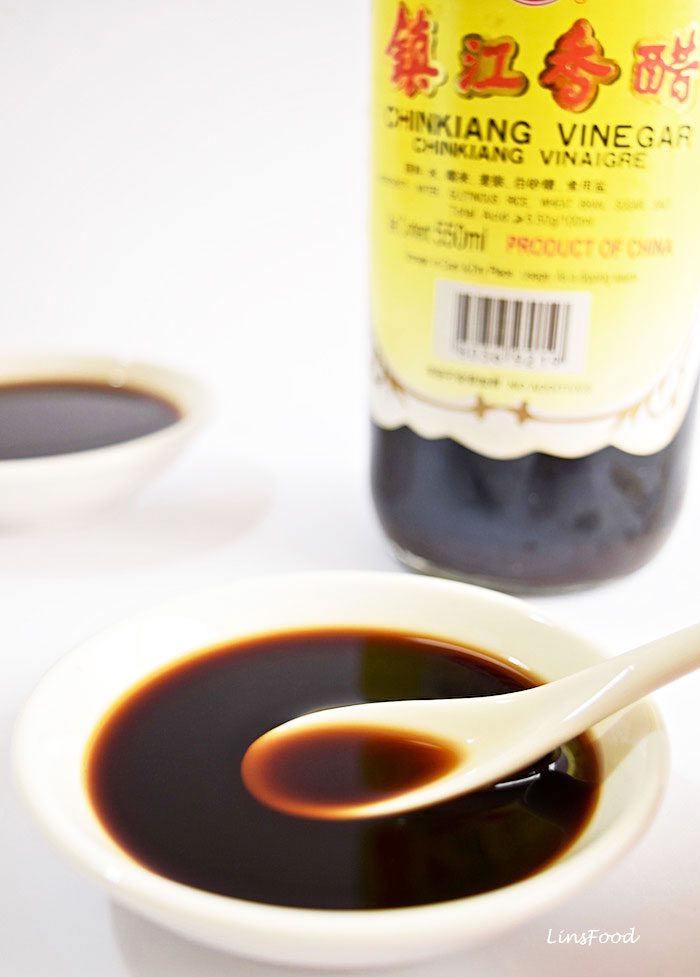Saliva Chicken is a beautiful contrast between the almost bland, lightly poached chicken and the tingly, spicy, slightly tangy chilli oil.
Estimated reading time: 9 minutes
Table of contents
- What’s in a Name?
- There’s Chinese Food, then there’s CHINESE Food!
- Chinese Cooking Classes in my Kitchen
- Cooking Saliva Chicken at Home
- Making the Saliva Chicken Red Sauce
- What to do with the extra Sichuan Chilli Oil?
- Other Uses for the Sichuan Chilli Oil:
- Poaching the Chicken
- “Pesky” Ingredients in the Saliva Chicken
- How do you serve Saliva Chicken?

What’s in a Name?
I know, Saliva chicken is not the most appetising of names for a dish but unfortunately, that is the direct translation of the Chinese recipe name, Kou Shui Ji (口水鸡).
Delicious, Scrumptious et al, don’t quite cut it. Drool worthy or mouthwatering are probably better sounding alternatives. But if truth be told, I’ve always cringed at both descriptions too!
Whatever name you are, or are not comfortable with, let me assure you, no saliva was harmed in the making of!
There’s Chinese Food, then there’s CHINESE Food!
I used to employ this Chinese lady, Jenny Tsu, to come and give Chinese cooking classes for me. This was at our old place, when all my classes were run out of my big kitchen.
Coming from Singapore, I’ve always cooked Chinese food, but Singaporean Chinese food is not quite the same as Chinese food from China. Know what I mean?
But don’t get me wrong, we’re not talking Americanised or Anglicised dishes. Singaporean Chinese food is “proper” Chinese, like Hainanese Chicken Rice (I hear you, I’ll blog it soon!), and the very, very Singaporean, Bak Chor Mee (now on my latest site, Singaporean and Malaysian Recipes):
But there are some dishes that didn’t travel to Singapore and Malaysia with the immigrants in the 18th and 19th centuries, like today’s Saliva Chicken.

Chinese Cooking Classes in my Kitchen
So, back to Jenny. I met the lady at our local Chinese grocer; we got to talking, and one thing led to another. She ended up teaching fortnightly classes for just over a year, and in that time, we covered foods from all over China, along with another Chinese chef who used to do classes sporadically.
Needless to say, I learnt along with my students, and after she left, I took over her classes, as it was just the natural thing to do. So this is one of Jenny’s recipes, and the first time I tasted it, well, what can I say? I salivated drooled!
The contrast between the almost bland, lightly poached chicken and the tingly, spicy, slightly tangy chilli oil is so exquisitely vivid, you almost start seeing stars!
It enslaves you. It hangs on to your soul until the very last bite, and the English teacher in me thinks this is the perfect (mis)quote: it “makes hungry where most it satisfies”.
Antony and Cleopatra, (Act II, Sc II)

Cooking Saliva Chicken at Home
There are a few steps to the recipe:
- We make the Sichuan Chilli Oil – this goes into making our Red Sauce
- Poach the chicken (cook it by steeping it in hot water briefly)
- Make the Red Sauce that goes all over the chicken
- Bring it all together – take the chicken out of the hot water, chop it up and serve on a plate with the sauce all over

Making the Saliva Chicken Red Sauce
The Red Sauce that you see all over the chicken and the plate, is the defining flavour in this Saliva Chicken recipe. It is spicy, aromatic and tangy and is made up of:
- Shaoxing wine
- Chinese black vinegar
- sesame oil
- white sugar
- garlic
- 1 tsp salt
- light soy sauce
To make the Saliva Chicken Sauce, we first make our own Sichuan Chilli Oil. A few tablespoons of the Sichuan chilli oil is then added to the ingredients mentioned above to make up the Red Sauce.
If you have access to ready made good quality Sichuan oil, and fancy “cheating”, by all means, go right ahead.
Sichuan food is well known for its spiciness, along with its tingly Sichuan peppercorns (see below). You can control the heat level by using less chillies, and/or change the type of chillies by using milder chilli flakes and mild chilli powder, and you’ll be able to enjoy this dish without crippling heat.
Dried chillies – Dried Sichuan peppers are hot. Substitute them with dried kashmiri chillies, and use just 2 of them in this recipe, for less heat.
What to do with the extra Sichuan Chilli Oil?
We will only be using a few tablespoons of our Sichuan Chilli Oil to make the red Sauce. Store the rest in a sterilised jar and keep in the fridge. It will last a good 6 months.
When you want to use it, give it a stir, then scoop out some of the oil, with all the bits; I have to warn you, you’ll get addicted very quickly!
You could also just scoop out the oil, if you want, to drizzle or to use as a stir fry oil.
With bits or without – completely up to you, depending on your mood and what you are using it for!
Other Uses for the Sichuan Chilli Oil:
- It makes a very convenient condiment. As I cannot have a meal without some sort of spice, the Sichuan Chilli Oil makes a great flavour and spice enhancer at meal times, much like the sambal belacan does. In this instance, I would stir and use with all the lovely bits in it.
- I also use it in stir fries. When a recipe calls for chillies or chilli paste, just use this Sichuan Chilli Oil, with the actual oil substituting the oil in your recipe. The result is a fabulous, deep and spicy dish. Here, I use just the oil, no bits, but do what you want!
- I love to spice up mayo and aioli with this chilli oil, when using them as dips or in sandwiches. Again, just the oil, no bits.
- Speaking of sandwiches, oh man, just lightly brush your chosen bread with a layer of this Sichuan Chilli Oil, whatever filling you have, and you’ll be in heaven! Just the way my granny used to make her sambal sandwiches! Definitely with all those yummy bits.
- As part of a marinade, it adds oomph to any baked or roast dish you’re planning. For eg, add a tablespoon (or more) of this to our Sichuan Roast Chicken, for an even spicier result. With or without bits will work.

Poaching the Chicken
Traditionally, a whole chicken is used for this dish; poached whole, then cut up. I prefer to use chicken legs as they make for a prettier presentation and easier serving. Plus the fact that I’m a huge fan of the darker meat.
You could also use chicken breasts if you prefer, but get them on the bone if you can. Poach them for just 10 – 15 minutes, depending on their thickness.
And this Saliva Chicken is meant to be cooked and eaten with its skin on; the soft skin, covered, and dripping with the chilli oil sauce, is one of the best pleasures to be had! So leave the skin on – we’ve already ascertained that this is no diet food!
When you’ve taken the chicken out, keep the poaching liquid. Add some seasoning (garlic, ginger, salt and pepper) and vegetables like some shredded cabbage and thinly sliced carrots. Cook it lightly until the vegetables are done (the cabbage won’t need long at all) and turn it into a light soup (broth) to serve with this Saliva Chicken and some rice.

“Pesky” Ingredients in the Saliva Chicken
Sichuan Peppercorns
Click here to read more. Despite the name, Sichuan peppercorns are not peppercorns and therefore, not related to our common black peppercorns at all! Sichuan peppercorns are the highly aromatic husks of the prickly ash berries which are dried and sold and they look like miniature flowers.
Their claim to fame is their mouth numbing characteristic; you get a tingling sensation on your tongue which sets the stage for the typically spicy dishes found in Sichuan cuisine.
That is why, you’ll often (but not always) find them in fiery Sichuan dishes with hot chillies, this mouth numbing trait is believed to reduce the crippling heat of the chillies used, letting diners enjoy the flavours of the dish.
If you can’t get Sichuan peppercorns, leave them out, although you should be able to find them easily if you have access to Chinese grocers, online or otherwise.
Here’s my global Amazon affiliate link to get them.
Chinese Black Vinegar
Click here to read more about it and for how to substitute it. Chinese Black Vinegar (below) is, as its name, suggests, a very, very dark vinegar. It is also quite commonly known as Chinkiang vinegar and has a very deep character, is a touch smoky with hints of sweetness right at the back of it all.
Click here to get it on Amazon (affiliate link).

Shaoxing Wine
Is Chinese rice wine, made from fermented rice. Easily substituted with dry sherry. If you don’t do alcohol, then just add a quarter tsp of regular, white vinegar for every tablespoon of rice wine, as a substitute for any recipe.
Here in the UK, this can be found in most of our major supermarkets, and definitely in Chinese, Japanese and Korean shops. I get mine from my local Korean as they have a bigger batch. But in the past, have bought it with my groceries from Ocado.
How do you serve Saliva Chicken?
The best way to enjoy the multi dimensional flavour of the Red Sauce is to pair it with some regular, old steamed white rice. Nothing allows you to savour a complex dish better than a bowl of white rice. When I have any left over, I have it for lunch the next day with just some salad and rice.
Kou Shui Ji makes the perfect centrepiece on any Oriental themed dinner table, or it can be one of many side dishes, if serving a big group. For more ideas and for similar recipes, head on over to the Chinese Page and the Singapore and Malaysia Page, for recipes like:


If you like the recipe, don’t forget to leave me a comment and that all important, 5-star rating! Xiè xiè
And if you make the recipe, share it on any platform and tag me @azlinbloor, and hashtag it #linsfood
Lin xx

Kou Shui Ji (口水鸡), Sichuan Chicken in Chilli Oil, aka Saliva Chicken!
Ingredients
Homemade Sichuan Chilli Oil
- 250 ml (1 cup) vegetable or peanut oil
- 2 Tbsp Sichuan peppercorns
- 1 bay leaf
- 1 star anise
- 1 small cinnamon stick
- 5 dried Sichuan peppers torn in half (or any other non-smoked, dried, red chillies)
- 5 cm (2") ginger, sliced
- 2 spring onions scallions, torn in half
- 2 cloves garlic sliced
- 1 handful unsalted toasted peanuts
- 1 Tbsp toasted sesame seeds
- 2 Tbsp red chilli flakes
- 1 tsp hot chilli powder
- 1 tsp salt
For Poaching the Chicken
- 4 chicken legs
- 5 cm (2") ginger, sliced
- 3 spring onions scallions, chopped in large pieces
- 1 Tbsp Shaoxing wine
- 2 Tbsp light soy sauce
- dash of ground white pepper
- enough water to cover the ingredients
The Red Sauce Ingredients
- 2 Tbsp Shaoxing wine
- 1 Tbsp Chinese black vinegar
- 1 Tbsp sesame oil
- ½ tsp white sugar
- 1 clove garlic finely chopped
- 1 tsp salt
- 1 Tbsp light soy sauce
Garnish
- coriander leaves cilantro, chopped
- 1 spring onion scallions, sliced
- 1 red chilli sliced
Instructions
Let’s Start with Making the Sichuan Chilli Oil
- Heat the oil in a small saucepan on low heat and add the Sichuan peppercorns, dried Sichuan peppers, bay leaf, star anise, cinnamon, ginger, spring onions (scallions) and garlic. Bring to a simmer and cook for 10 minutes, by which time, all the aromatics will be brown-ish and wrinkly.
- While waiting for the oil above, crush the peanuts to a coarse grind, either in a chopper or place in a bag and go over with a rolling pin. Or in a pestle and mortar. However you prefer to do it.
- Place the crushed peanuts in a large bowl big enough to take the oil that’s cooking away.
- Add the sesame seeds, chilli flakes and salt to the bowl of peanuts.
- When the oil is done at 10 minutes, immediately strain the very hot oil onto the dry peanut mix, using a metal strainer. Just in case your plastic one isn’t heatproof. Set aside.
Let’s Poach the chicken
- Bring a large saucepan of water to boil and add the ginger, spring onions (scallions), Shaoxing wine, soy sauce and white pepper.
- When the water is boiling, put the chicken legs in and bring the water back up to boil on high heat.
- As soon as the water is boiling, turn cover the saucepan, turn the heat off and take the saucepan off the hot hob.
- Leave the chicken legs to poach for 20 minutes. While the chicken is poaching, we’ll move on to the chilli oil.
Let’s Make the Red Sauce
- Place all the sauce ingredients into a medium sized bowl and add 4 tablespoons (more or less, to taste) of the Sichuan chilli oil in and mix thoroughly. Set aside.
Time to Serve up the Saliva Chicken!
- Take the chicken out of the poaching liquid, and cut into pieces, on a chopping board, right through the bone. You would have to use a very sharp/big knife like a meat cleaver. Or a sharp knife with a hammer to drive through the bones! Whatever you have that works!
- Place the chicken pieces onto individual serving dishes or onto a large serving platter.
- Spoon the Sichuan chilli oil sauce all over the chicken, garnish and serve immediately, with some rice and some of the soup made from the poaching liquid.

Well, the name Saliva chicken I thought I read wrong! 😀 It is a totally new dish for me and I will love to eat it. Since I do not cook any kind of meats I am thinking that I can use as a substitute. I definitely want to try it out! Looks awesome, sounds yum!
Wow. Can I just say wow? I just did a search for saliva chicken and yours was in the top few of the results. I’ve looked at all that were on the first page and yours is the easiest recipe and instructions to follow. I just love how you break it all down and also explain how to use up extras. Just wow. I’ve subscribed to your blog!
Thank you, Penny, this is a superb dish, isn’t it?
I’ve had this before, just didn’t know what it was called… thankfully. lol
Haha, many thanks for stopping by!
Looks delicious. I am always looking for new recipes for chicken since we eat that quite often.
Thank you!
Oh my goodness!!! This looks so delicious and easy to make. perfect for dinner one night this week.
I like the idea of a bland chicken smothered in a sauce with chili. It sounds like a good combination. I’d love to try and cook this for me and my husband.
Thank you Carol, it makes for a nice, if spicy, change!
It sounds a little off if you don’t give it a chance. I’ve never tried this before but it looks so appetizing! I would love to try it.
Thank you.
oh man that looks amazing. i haven’t had dinner yet and i wish i could make this really fast. saving for later.
Thank you Katrina!
This looks like a delicious dish! I love trying/cooking new foods, so I’ll have to try making it!
Thank you!
Oh my goodness this recipe looks so good. Thank you so much for including a separate recipe for the chili oil. I’m looking forward to trying it is I like spicy things
Thank you, Jennifer, me too!
This sounds divine, I love any dishes served with rice! I can’t wait to give this recipe a try!
Thanks Chloe, let me know how it goes!
Oh my goodness this looks truly delicious!!! I have absolutely no patience when it comes to cooking but I would love to try this!
Lol, thank you!
You’re right, it doesn’t have a very appetizing name but it certainly sounds delicious (and I’m not even a fan of chilli!)
This is a tasty looking dish! I’ll have to add this recipe to my book!
Thank you!
wow!This looks amazing!I always love to try Chinese dishes.Sure,I will try this chicken recipe soon.
Thank you Amila!
This looks so good! I love spicy foods, and I am always down to try a new recipe! This is getting made in my house soon.
This looks so delicious! The colors are so rich I bet it tastes as good as it looks!
This looks so spicy, I feel like my mouth is burning already. Lol. I know my husband would love it, so I’m going to give it a try! Thanks for the recipe.
Mmm. I love spicy foods, so I’d enjoy this. It looks amazing!
This looks good, but I don’t know what I’d make of all that oil. I think I’d end up being the weird person who takes all the chicken out and blots it.
Girl do you know how to cook !!! This recipe looks amazing and I can’t wait to try it out soon